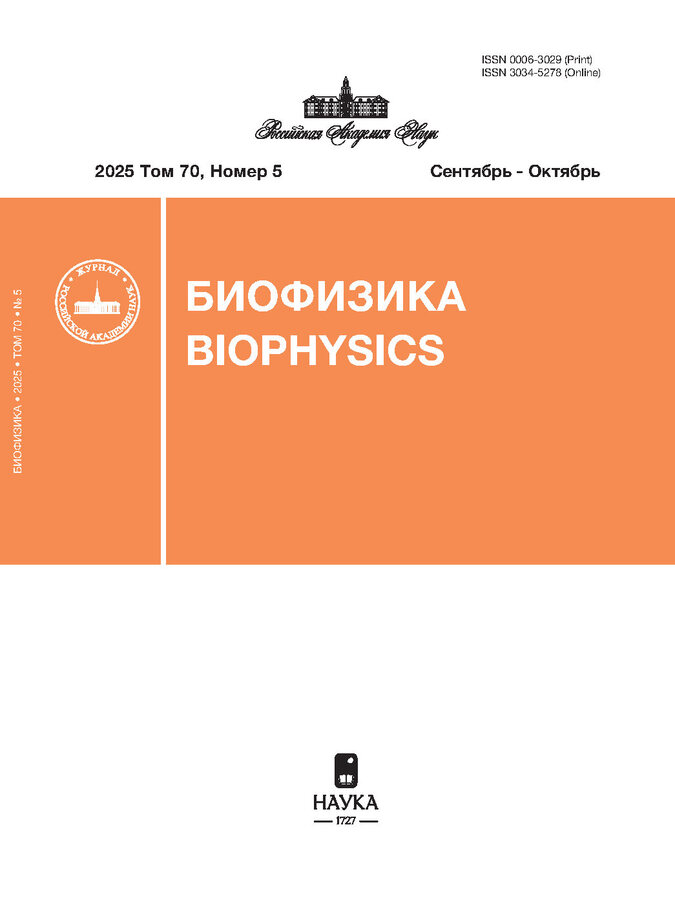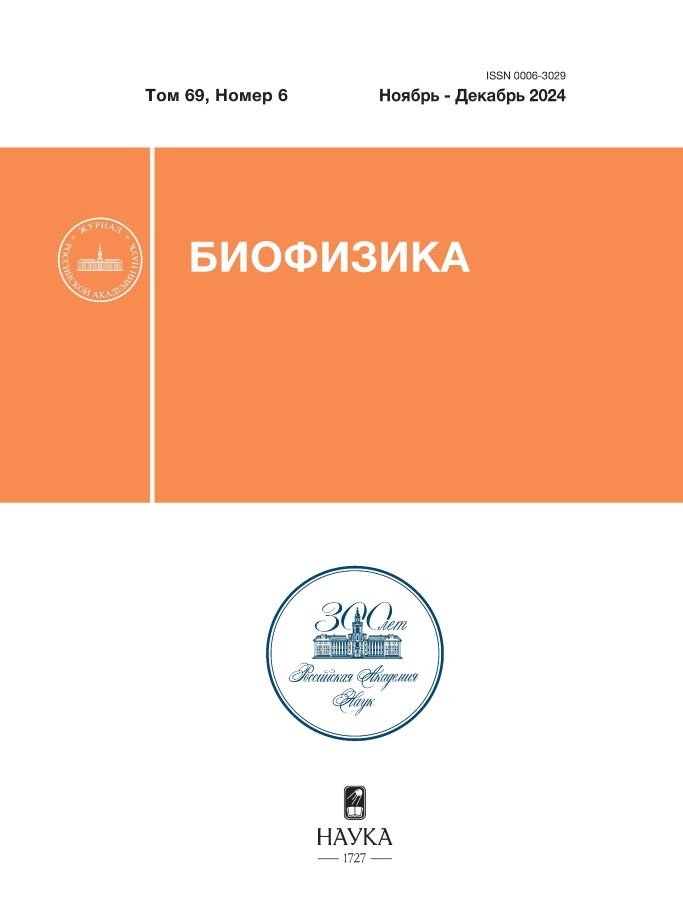ТРАНСПОРТ ГЛИЦЕРИНА ЧЕРЕЗ МЕМБРАНУ СПЕРМАТОЗОИДА ЧЕЛОВЕКА ПРИ КРИОКОНСЕРВАЦИИ
- Авторы: Иванова А.А1, Леонов И.И1, Гнилозуб-Волобуева Е.С1, Овчинников М.А2, Яковенко С.А1, Симоненко Е.Ю1
-
Учреждения:
- Московский государственный университет имени М.В. Ломоносова
- Научно-исследовательский институт ядерной физики им. Д.В. Скобельцына Московского государственного университета имени М.В. Ломоносова
- Выпуск: Том 69, № 6 (2024)
- Страницы: 1175-1184
- Раздел: Биофизика клетки
- URL: https://cardiosomatics.ru/0006-3029/article/view/676132
- DOI: https://doi.org/10.31857/S0006302924060048
- EDN: https://elibrary.ru/NLVXVG
- ID: 676132
Цитировать
Полный текст
Аннотация
Ключевые слова
Об авторах
А. А Иванова
Московский государственный университет имени М.В. Ломоносова
Email: Annetkurella@yandex.ru
Физический факультет Москва, Россия
И. И Леонов
Московский государственный университет имени М.В. ЛомоносоваФизический факультет Москва, Россия
Е. С Гнилозуб-Волобуева
Московский государственный университет имени М.В. ЛомоносоваФизический факультет Москва, Россия
М. А Овчинников
Научно-исследовательский институт ядерной физики им. Д.В. Скобельцына Московского государственного университета имени М.В. ЛомоносоваМосква, Россия
С. А Яковенко
Московский государственный университет имени М.В. ЛомоносоваФизический факультет Москва, Россия
Е. Ю Симоненко
Московский государственный университет имени М.В. ЛомоносоваФизический факультет Москва, Россия
Список литературы
- Kroløkke С. Life in the cryo-kennel: The ‘exceptional’ life of frozen pet DNA. Soc. Stud. Sci., 49 (2), 162-169 (2019). doi: 10.1177/0306312719837610
- Hildebrandt T. B., Hermes R., Goeritz F., Appeltant R., Colleoni S., de Mori B., Diecke S., Drukker M., Galli C., Hayashi K., Lazzari G., Loi P., Payne J., Renfree M., Seet S., Stejskal J., Swegen A., Williams S.A., Zainuddin Z. Z., Holtze S. The ART of bringing extinction to a freeze - History and future of species conservation, exemplified by rhinos. Theriogenology, 169, 76—88 (2021). doi: 10.1016/j.theriogenology.2021.04.006
- Jaiswal A. N. and Vagga A. Cryopreservation: A review article. Cureus 14 (11), e31564 (2022). doi: 10.7759/cureus.31564
- Elliott G. D., Wang S., and Fuller B. J. Cryoprotectants: A review of the actions and applications of cryoprotective solutes that modulate cell recovery from ultra-low temperatures. Cryobiology 76, 74—91 (2017). doi: 10.1016/j.cryobiol.2017.04.004
- Žáková J., Lousová E., Ventruba P., Crha I., PochopováH., Vinklárková J., Tesařová E., and Nussir M. Sperm cryopreservation before testicular cancer treatment and its subsequent utilization for the treatment of infertility. Sci. World J., 2014, 575978 (2014). doi: 10.1155/2014/575978
- Tamburrino L., Traini G., Marcellini A., Vignozzi L., Baldi E., and Marchiani S. Cryopreservation of human spermatozoa: functional, molecular and clinical aspects Int. J. Mol. Sci., 24 (5), 4656 (2023). doi: 10.3390/ijms24054656
- Hezavehei M., Sharafi M., Kouchesfahani H. M., Henkel R., Agarwal A., Esmaeili V, and Shahverdi A. Sperm cryopreservation: A review on current molecular cryobiology and advanced approaches. Reprod. Biomed. Online, 37 (3), 327-339 (2018). doi: 10.1016/j.rbmo.2018.05.012
- Colás C., Junquera C., Pérez-Pé R., Cebrián-Pérez J. A., and Muiño-Blanco T. Ultrastructural study of the ability of seminal plasma proteins to protect ram spermatozoa against cold-shock. Microsc. Res. Technique, 72 (8), 566572 (2009). doi: 10.1002/jemt.20710
- Aliakbari F., Taghizabet N., Azizi F., Rezaei-Tazangi F., Gelehkolaee K. S., and Kharazinejad E. A review of methods for preserving male fertility. Zygote, 30, 289-297 (2022). doi: 10.1017/S0967199421000071
- Gao D. and Critser J. K. Mechanisms of cryoinjury in living cells. ILAR J., 41 (4), 187-196 (2000). doi: 10.1093/ilar.41.4.187
- Chatterjee S. and Gagnon C., Production of reactive oxygen species by spermatozoa undergoing cooling, freezing, and thawing. Mol. Reprod. Devel., 59 (4), 451-458 (2001). doi: 10.1002/mrd.1052
- Белоус А. М. и Грищенко В. И. Криобиология (Наук. думка, Киев, 1994).
- Popov I., Greenbaum (Gutina) A., Sokolov A. P., and Feldman Y. The puzzling first-order phase transition in water-glycerol mixtures. Phys. Chem. Chem. Phys. 17 (27), 18063-18071 (2015). doi: 10.1039/C5CP02851E
- Ozimic S., Ban-Frangez H., and Stimpfel M. Sperm cryopreservation today: approaches, efficiency, and pitfalls. Curr. Issu. Mol. Biol., 45 (6), 4716-4734 (2023). doi: 10.3390/cimb45060300
- A. M. Hossain, C. O. Osuamkpe, Archives ofAndrology 53 (2), 99 (2007). doi: 10.1080/01485010701225675
- K. Murata and H. Tanaka, General nature of liquid-liquid transition in aqueous organic solutions. Nature Commun., 4, 2844 (2013). doi: 10.1038/ncomms3844
- Fuller B. J. Cryoprotectants: the essential antifreezes to protect life in the frozen state. Cryo Lett., 25 (6), 375-388 (2004). PMID: 15660165
- Roy S., Arora S., Kumari P., and Ta M. A simple and serum-free protocol for cryopreservation of human umbilical cord as source of Wharton's jelly mesenchymal stem cells. Cryobiology, 68 (3), 467-472 (2014). doi: 10.1016/j.cryobiol.2014.03.010
- Gurruchaga H., del Burgo L. S., Garate A., Delgado D., Sanchez P., Orive G., Ciriza J., Sanchez M. and Pedraz J. L. Cryopreservation of human mesenchymal stem cells in an allogeneic bioscaffold based on platelet rich plasma and synovial fluid. Sci Rep., 7 (1), 15733 (2017). doi: 10.1038/s41598-017-16134-6
- Arutyunyan I. V, Kananykhina E. Yu., Elchaninov A. V, and Fatkhudinov T. Kh. Influence of sucrose on the efficiency of cryopreservation of human umbilical cord-derived multipotent stromal cells with the use ofvarious penetrating cryoprotectants. Bull. Exp. Biol. Med., 171 (1), 150 (2021). doi: 10.1007/s10517-021-05187-3
- Gao D. Y., Mazur P., Kleinhans F. W., Watson P. F., Noiles E. E., and Critser J. K. Glycerol permeability of human spermatozoa and its activation energy. Cryobiology, 29 (6), 657-667 (1992). doi: 10.1016/0011-2240(92)90068-d
- Pellavio G. and Laforenza U. Human sperm functioning is related to the aquaporin-mediated water and hydrogen peroxide transport regulation. Biochimie, 188, 45-51 (2021). doi: 10.1016/j.biochi.2021.05.011
- Gilmore J. A., McGann L. E., Liu J., Gao D. Y., Peter A. T., Kleinhans F. W., and Critser J. K. Effect of cryoprotectant solutes on water permeability of human spermatozoa. Biology of Reproduction, 53 (5), 985-995 (1995). doi: 10.1095/biolreprod53.5.985
- Nobel P. S. The Boyle-Van't Hoff relation. J. Theor. Biol., 23 (3), 375 (1969). doi: 10.1016/0022-5193(69)90025-3
- Lfe in the Frozen State, Ed. by B. J. Fuller, N. Lane, and E. E. Benson (CRC Press, Boca Raton, USA, 2004). doi: 10.1201/9780203647073
- Lahmann J. M., Benson J. D., and Higgins A. Z. Concentration dependence of the cell membrane permeability to cryoprotectant and water and implications for design of methods for post-thaw washing of human erythrocytes. Cryobiology, 80, 1-11 (2018). doi: 10.1016/j.cryobiol.2017.12.003
- Roudier N., Ripoche P., Gane P., Le Pennec P. Y., Daniels G., Cartron J.-P., and Bailly P. AQP3 deficiency in humans and the molecular basis of a novel blood group system, GIL. J. Biol. Chem., 277 (48), 45854-45859 (2002). doi: 10.1074/jbc.M208999200
- WHO Laboratory Manual for the Examination and Processing of Human Semen, 6th ed. (World Health Organization: Geneva, Switzerland, 2021).
- Roudier N., Verbavatz J.-M., Maurel C., Ripoche P., and Tacnet F. Evidence for the presence of aquaporin-3 in human red blood cells. J. Biol. Chem., 273 (14), 8407-8412 (1998). doi: 10.1074/jbc.273.14.8407
- Rodriguez R. A., Liang H., Chen L. Y., Plascencia-Villa G., and Perry G. Single-channel permeability and glycerol affinity of human aquaglyceroporin AQP3. Biochim. Biophys. Acta — Biomembranes, 1861 (4), 768-775 (2019). doi: 10.1016/j.bbamem.2019.01.008
- Kuche P. W., Cox C. D., Daners D., Shishmarev D., and Galvosas P. Surface model of the human red blood cell simulating changes in membrane curvature under strain. Sci. Rep., 11 (1), 13712 (2021). doi: 10.1038/s41598-021-92699-7
- Kedem O. and Katchalsky A. Thermodynamic analysis of the permeability of biological membranes to non-electro-lytes. Biochim. Biophys Acta, 27, 229-246 (1958). doi: 10.1016/0006-3002(58)90330-5
- Du J., Kleinhans F. W., Mazur P., and Critser J. K. Human spermatozoa glycerol permeability and activation energy determined by electron paramagnetic resonance. Biochim. Biophys. Acta — Biomembranes, 1194 (1), 1-11 (1994). doi: 10.1016/0005-2736(94)90196-1
- Fujii T., Hirayama H., Fukuda S., Kageyama S., Naito A., Yoshino H., Moriyasu S., Yamazaki T., Sakamoto K., Hayakawa H., Takahashi K., Takahashi Y., and Sawai K. Expression and localization of aquaporins 3 and 7 in bull spermatozoa and their relevance to sperm motility after cryopreservation. J. Reprod. Devel., 64 (4), 327335 (2018). doi: 10.1262/jrd.2017-166
Дополнительные файлы











